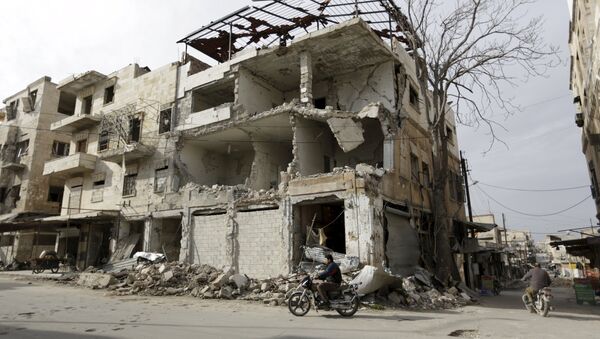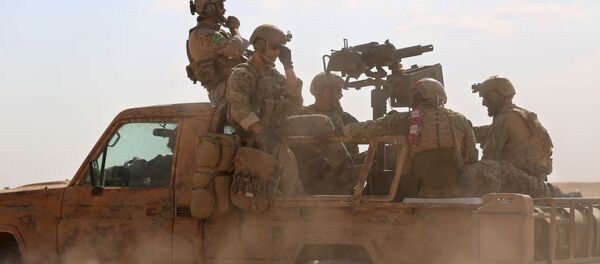This amounts to a brazen pulling of rank by the militarist elements within the US power structure over the civilian titular head of government. This power struggle came to light dramatically – if briefly – with the US air strike last weekend on the Syrian army base near Deir ez-Zor in which over 60 troops were killed.
Within hours of the Deir ez-Zor attack on Saturday evening, there were reports of air strikes on civilian areas of insurgent-held eastern Aleppo. But none of the reports were able to confirm the identity of the warplanes involved.
Two days later, media coverage shifted to the collapse of the Syrian ceasefire and what is being described as an “outrageous” air strike by Syrian or Russian warplanes on a UN aid convoy near the northern city of Aleppo. Again, no reports have been able to identify the aircraft alleged to have perpetrated that attack, although Washington blamed Syria and its Russian ally.
Predictably, following the attack on the humanitarian convoy in which 12 civilian aid workers were killed and several trucks ferrying food were destroyed, the US is saying that plans to cooperate with Russian military in Syria are now off the agenda.
But it is the aforementioned sequence of violence that needs to be particularly ascertained in order to appreciate the real significance of why and how the latest Syrian ceasefire has broken down.
First of all, we should note that the Pentagon and its CIA covert arm were conspicuous in their dissent to the Obama administration’s diplomatic efforts to implement a ceasefire in partnership with Russia.
Nevertheless, Obama and his top diplomat Kerry persisted – despite the objections of the US military – in coming up with a “deal” with Russia that envisaged a cessation of violence, humanitarian aid to war-torn cities like Aleppo, and, remarkably, an ambitious proposal for US and Russian military forces to form a joint task force to go after al-Qaeda-linked terror groups, such as the rebranded al-Nusra Front and Daesh (ISIS/ISIL/IS).
For the ceasefire to take hold and for US-Russia joint operations to begin, the Kerry-Lavrov deal hinged on the separation of US-backed supposed “moderate rebels” from the notorious al-Qaeda-type extremists.
Even as the ceasefire came into effect on September 12, the Pentagon was contemptuously voicing doubts about its success. It was obvious that the US military establishment did not want the ceasefire arrangement with Russia. That dissent was tantamount to subverting Obama’s presidential authority and his favored diplomatic option.
Why was the Pentagon antsy over the ceasefire plan with Russia? After demonizing Moscow as a global threat for the past two years, part of the Pentagon’s aversion was that any successful partnership with Russia over Syria would be a pointed negation to the hype of the new Cold War over Ukraine and Europe.
More importantly, however, is that the Pentagon and the CIA knew that in Syria the White House spiel about “moderates” and “terrorists” being separable was always an illusion.
But the war planners in Washington know all too well that in the real world of America’s dirty war in Syria there is no such division of “good” and “bad” rebels among the insurgents. They are all part of a proxy terror front of illegally armed militants, which the US and its NATO and Arab allies have funded, armed, trained and directed for the past six years to overthrow the Syrian government.
A second crucial reason for why the US military planners opposed the ceasefire was because they were apprehensive that if the truce failed – as it surely would – then the failure would demonstrate the fallacy of the official Washington narrative of it only supporting “legitimate, moderate, vetted rebels”.
And, thirdly, if somehow the US and Russian air forces were to get to the stage of carrying out joint strikes against terror units that would be the ultimate anathema for the Pentagon and CIA. In that unlikely event, the Americans would be obliged to disclose to the Russians where their supposed “moderate rebels” are located. Which, as noted, is a fabrication. What the US and Russia would be targeting are covert American regime-change assets, which is impermissible for Washington’s war planners.
The Pentagon’s misgivings were founded too. From the outset of the ceasefire, all the anti-government militant groups were engaging in breaches. And, glaringly, there was no separation of any of the insurgents, as John Kerry had appealed for. In other words, the American official narrative about the Syrian war was being exposed as a huge lie. And America’s involvement in sponsoring a terrorist front in Syria was becoming transparent.
The ceasefire regime was abided by Syria and Russia, but it was the US-backed militants who continued acts of terrorism, preventing, for example, humanitarian access to Aleppo all last week because of shelling and sniping at the Castello Road arterial route.
In short order, a series of unidentified warplanes carried out strikes in and around Aleppo, including the blast on the UN aid convoy. No one knows as yet who carried out those strikes, but it is plausible that they were false flag attacks by US forces intent on obliterating the waning ceasefire, and distracting from the earlier US massacre at Deir ez-Zor.
Now, conveniently, Washington is declaring no cooperation with Russia in Syria and the ceasefire is dead.
Thus, the Pentagon has pulled rank on the White House’s diplomacy with Russia. And US policy is under military rule. Nothing new there, one might say, except how blatant the subversion.
The views expressed in this article are solely those of the author and do not necessarily reflect the official position of Sputnik.








